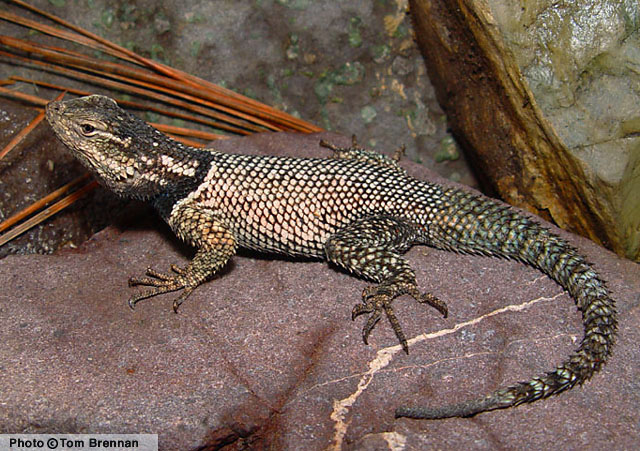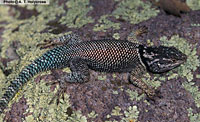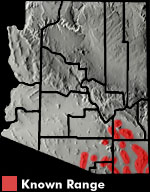Online Field Guide to The Reptiles and Amphibians of Arizona



Cochise Co., AZ
 Cochise Co., AZ |
| YARROW’S SPINY LIZARD Sceloporus jarrovii | |
|
DESCRIPTION: A medium-sized (up to 105 mm or 4.1″ from snout to vent), lizard with large, pointed, keeled, overlapping scales and a broad, black collar. The rear edge of the collar is bordered by a thin, white line. Base coloration is gray or olive-gray. Upon emerging from shelter specimens may be very dark gray or black. The top of the head is plain dark gray or olive-gray. Each body scale is pale and edged in black giving the torso a net-like pattern. The pale body scales reflect tints of pink, orange, copper, blue, and green. The underside is off white or gray. Males have blue patches on the throat and sides of the belly. Belly markings are faint or absent in females. The scales on the tail are larger and more spiny than those of the body. Males have blue patches on the belly and throat. Belly and throat patches are faint or lacking in females. Its complete collar distinguishes this lizard from Arizona’s other Sceloporus. DISTRIBUTION: This lizard’s is found in the sky island mountain ranges of southeastern Arizona at elevations ranging from about 4,300′ to over 10,000′. It has been introduced to the Santa Catalina mountains north of Tucson. HABITAT: An inhabitant of Madrean Evergreen Woodland, Petran Montane Conifer Forest, and Petran Subalpine Conifer Forest communities. It is found in rocky canyon bottoms, on cliff faces, boulder fields, talus slopes, and outcroppings. BEHAVIOR: This diurnal rock-dweller can be active at any time of the year but winter activity is usually restricted to unseasonably warm, sunny days. In winter this lizard shares communal shelters. Winter shelters usually consist of crevices on a south-facing cliff or rock outcropping. In the warm months both males and females are territorial and chase other lizards out of their home range. It is often relatively easy to approach but may retreat into a crevice or rock pile if persistently harassed. DIET: Yarrow’s Spiny lizard sits and waits for prey to wander within close proximity. It feeds on a variety of insects including beetles, grasshoppers, ants, wasps, and caterpillars. It also feeds on a variety of spiders. REPRODUCTION: This live-bearing lizard mates in fall and gives birth to up to 14 young in late June. Females are able to store sperm over the winter and delay embryonic development until temperatures rise in spring. By Thomas C. Brennan Brennan, T. C., & A. T. Holycross. 2006. A Field Guide to Amphibians and Reptiles in Arizona. Arizona Game and Fish Department. Phoenix, AZ Degenhardt, W. G., Painter, C. W., and Price, A. H.. 1996. Amphibians and Reptiles of New Mexico. University of New Mexico Press. Albuquerque. Stebbins, R.C. 2003. A Field Guide to Western Reptiles and Amphibians, Third Edition. Houghton Mifflin Company, Boston, MA. |
|
Visit Partners in Amphibian and Reptile Conservation:


HOME
Copyright © 2023, Arizona Game and Fish Department. All rights reserved.
If you make use of the textual contents of this site in reports, publications, etc. please cite and credit the author(s) and photographer(s). All photos on this website are copyrighted. However, those found in the species account section may be used for any noncommercial scientific, educational, or conservation purposes provided that photographs are not altered and continue to bear the copyright symbol and name of the photographer. Please contact the photographer regarding commercial use of copyrighted photographs.










